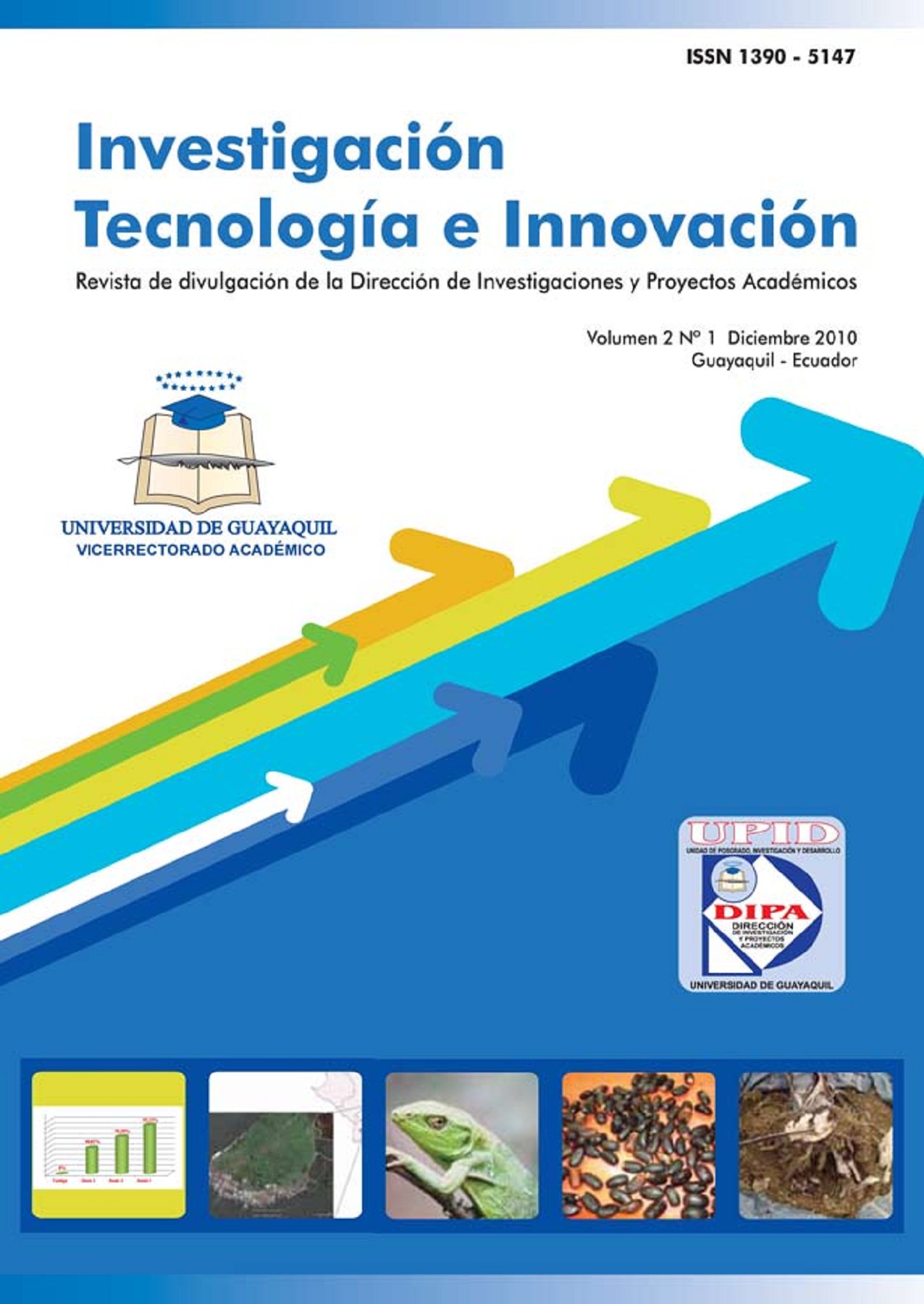Evaluation of the level of bacteriological pollution in water and sediment of the estuary, and his relation with the quality ofthe underground water of the commune Cerrito de los Morreños, gulf of Guayaquil - Ecuador
DOI:
https://doi.org/10.53591/iti.v2i2.106Keywords:
bacteria, coliforms, water, estuarine sedimentsAbstract
The Commune Cerrito de los Morrefíos is influenced by sewage dischargeddirectly bythe villagers and from the city ofGuayaquil, which affects waterquality, sediment and biota of the study area, resulting in the proliferation ofpathogens, which will have direct effects on the population because consumption of ground water (wells) and use of ecosystem services afforded by mangrove aquatic ecosystem and surrounding community. In the present work was used to coliform bacteria as indicators of organic pollution, applying the technique ofMost Probable Number (NMP). The average results analyzed, compared and correlated with the water matrix of the four selected stations of the estuary is as follows: the total bacteria concentrations were from 9.3 to 43.8 x 102 UFC/ml, total coliforms were found in concentrations of 22-54 x 102 NMP/IOOml and fecal coliforms from 9.3 to 92 x 102 NMP!l OOml, regarding the use ofwater in the estuary, according to the seasons, the number 3 and 4 by a low level of bacteria! concentration can be utilized in recreational activities (swirnming and fishing), while the analysis in community well water concentrations were <1.8 NMP!l OOml for total and fecal coliforms, however, in the prívate well showed the presence of total coliforms in concentrations greater than 1600 NMP!l OOml and 33-240 NMP!l OOml for fecal coliforms. What can be concluded that the quality of community well water consumed by residents ofthe community is suitable for domestic use, while the prívate well water pre-treatment needs for consumption. Sediment data show a tendency to be the siles themselves for the development of bacteria, which are related to direct discharges of domestic wastewater and organic waste from farm
animals in the community.
References
Barcenas, C., 1992. Los modelos de simulación en la ecotoxicología de zonas costeras, citado en en Becerra-Tapia N. y A. Botello, 1995. Bacterias Coliformes, fecales y patógenas en el sistema lagunar Chantuto-Panzacola, Chiapas, México.
Becerra-Tapia N. y A. Botello, 1995. Bacterias Coliformes, fecales y patógenas en el sistema lagunar Chantuto-Panzacola, Chiapas, México.
Bensen, H., 1994. Microbiological applications, citado en Figueroa-Zavala B., 2007. Contaminación de Origen Fecal en el corredor costero Barra de Tonameca-bahía de Puerto Ángel-La Mina, Oaxaca, México.
Davies, C.M., 1995, Microbiology, citado en Figueroa-Zavala B., 2007. Contaminación de Origen Fecal en el corredor costero Barra de Tonameca-bahía de Puerto Ángel-La Mina, Oaxaca, México.
Escobar, J., 2002, La contaminación de los rios y sus efectos en las áreas costeras y el mar, División de Recursos Naturales e Infraestructura, CEPAL, Naciones Unidas.
Fishman M. and S. Downs, "Methods for Analysis of Selected Metals in Water by Atomic Absorption", Geological Survay Water Supply Paper 1540-C, U, S. Government Printing Office, Washington, D. C. , 1996, citado en Perkin Elmer, 1996, Analytical Methods. Atomic Absorption Spectroscopy.
Ford T., y Colwell, 1996. A global decline in microbiological safety of water: a call for action, citado en Figueroa-Zavala B., 2007. Contaminación de Origen Fecal en el corredor costero Barra de Tonameca-bahía de Puerto Ángel-La Mina, Oaxaca, México.
Gruber. S.L, et. al., 2005. Sediments as a reservoir of indicator bacteria in a coastal embayment. Citado en Figueroa-Zavala B., 2007. Contaminación de Origen Fecal en el corredor costero Barra de Tonameca-bahía de Puerto Ángel-La Mina, Oaxaca, México.
Montaño M., et. al., 2006. Monitoreo y manejo de la calidad de agua costera. PMRC.
Orozco C. 2008. Caracterización fisicoquímica y bacteriológica de aguas subterráneas de pozos artesanales y efluentes hídricos en la Costa de Chiapas (México), Higiene y Sanidad Ambiental, 8: 348-354 (2008).
Rodríguez, A., 2002. Caracterización de la calidad de las aguas y sedimentos del rio Atacames, INOCAR-Acta Oceanográfica del Pacífico Vol. 12 (1) 2003-2004, pp. 13 -20.
Standard Methods for the Examination of Water and Wastewater, 2005, Edición 21.
Solórzano L., Boletín Científico y Técnico Vol. Vll, No. 1 "Instrumentación y Análisis Químico de Agentes Contaminantes en el Mar", Instituto Nacional de Pesca, Ecuador.
TEXTO UNIFlCADO DE LEGISLACIÓN AMBIENTAL, 2003, Libro VI Anexo 1-Norma de Calidad Ambiental y de Descarga de Efluentes: Recurso Agua.
Yanez-Arancibi. A y J. Zárate, l 992. Implicaciones ecológicas y de impacto ambiental, citado en Becerra-Tapia N. y A. Botello, l 995. Bacterias Coliformes, fecales y patógenas en el sistema lagunar Chantuto-Panzacola, Chiapas, México.
Downloads
Published
Issue
Section
License
Copyright (c) 2010 Víctor Arcos Cobos, Mariuxi Mero Valarezo, Mónica Machuca de la Torre, Lenin Vera Sari, Andrea Fuentes, Evelyn Flores, Fidel Egas, Johanna Feiz Espinoza, Vicente Velasteguí

This work is licensed under a Creative Commons Attribution-NonCommercial-NoDerivatives 4.0 International License.






